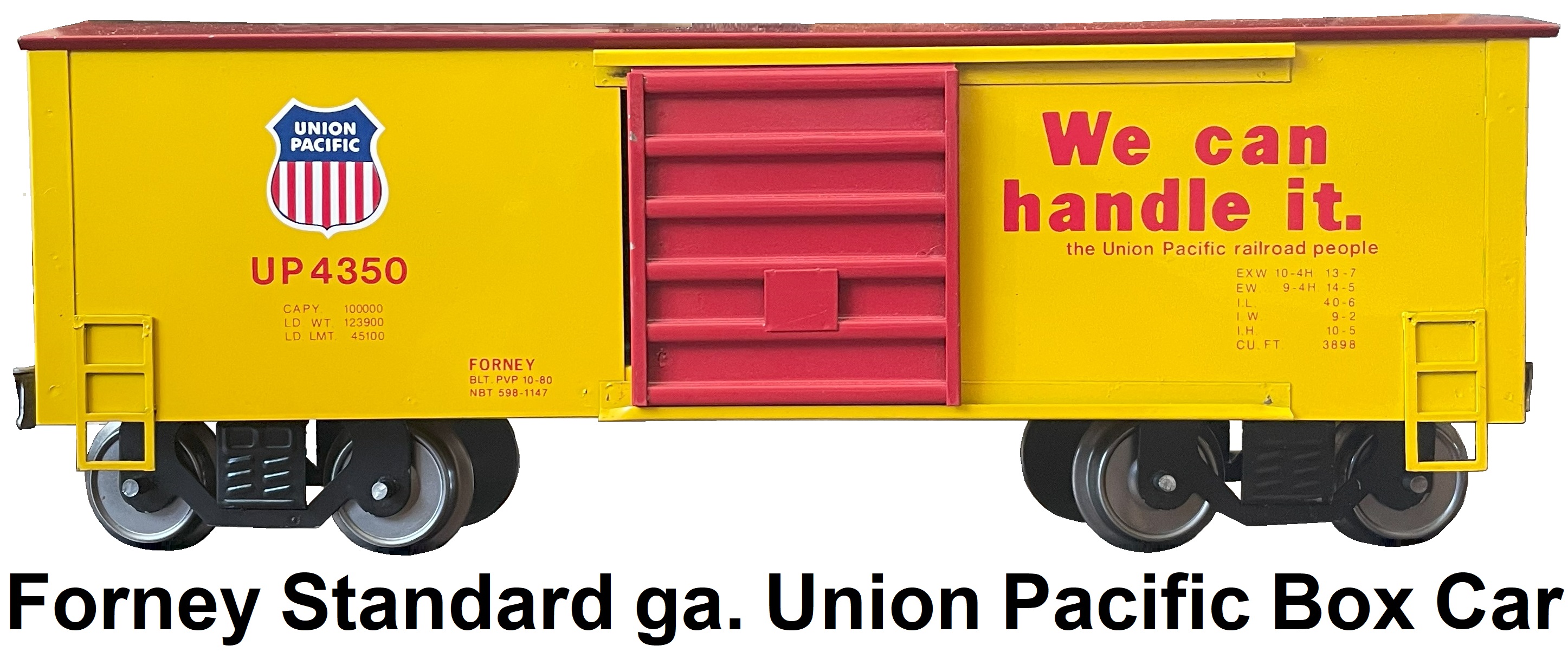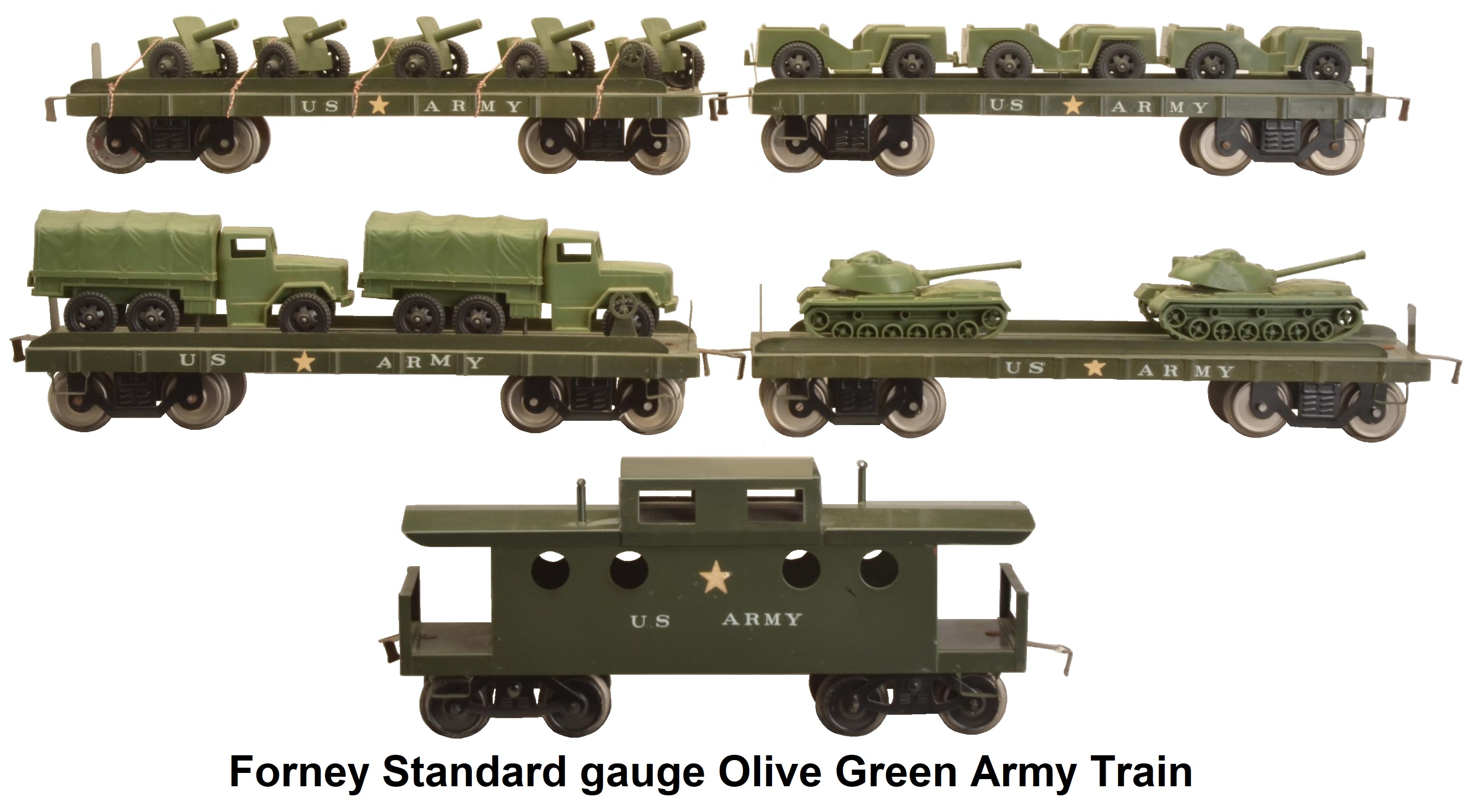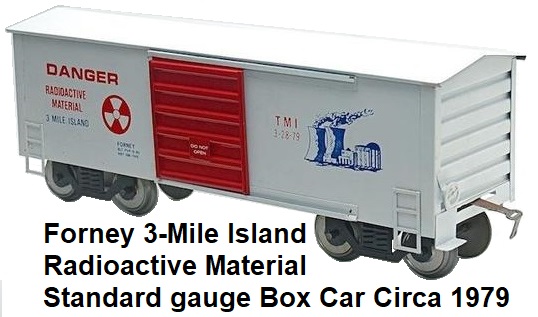Willard L. 'Red' Forney founded this company in Carlisle PA, in 1975 to manufacture realistic looking Standard
gauge steel trains. The firm operated during a 10 year period from 1975 to 1985. In prior years, Red Forney
had apprenticed in the McCoy shops at Kent, WA, where he learned the
art of making stamped steel standard gauge car bodies and was taught how to weld them by Margaret McCoy.

Wide or Standard gauge toy trains were popularized in the United States during the early
part of the 20th century by Lionel. Other US manufacturers such as
Ives, American Flyer, Dorfan, and
Boucher adopted this track gauge shortly thereafter. However, the trains made during
this period were tinplate toys and were not necessarily modeled after actual prototypical trains with any
degree of scale or accuracy to detail. By the 1940's the Standard gauge had disappeared from
the marketplace as the consuming public demanded more realistic prototypical models of trains, and
the lack of space in most homes now dictated a smaller gauge be employed to better utilize any available
room for an operating layout. 'O' gauge became the new 'standard' for the toy and model manufacturers of
the mid-twentieth century. 'OO' and HO gauges also became very popular with hobbyists who had limited
layout space and desired more prototypical realism.
 In the 1960's and early 70's there was a resurgence in the demand for the Standard gauge from collectors
who had grown up running such trains and wanted to relive their youthful memories. However, early 20th
century Standard gauge trains were now very rare, and those that were still around were now more valuable and
thus, operators were hesitant to run them with regularity. A couple of craftsmen and manufacturers such as
McCoy, Model Engineering Works,
Williams, the Treasure House, and Varney & Sirus
started to create and sell reproductions of some of the more
famous early 20th century Standard gauge toy trains. Soon thereafter, other manufacturers such as
Classic Model Corp., Jerry Brown,
Rich-Art Manufacturing, The Thorley Hoople Toy Company,
JAD Railway Lines, John Kresse, John Daniel Railway Lines,
and even McCoy started producing their own new lines of Standard gauge trains.
Many of these new products were modeled after real prototypes and many were original designs, but there
was clearly a movement away from the older, whimsical, early toy-like trains that were produced in the
1920's and 30's.
In the 1960's and early 70's there was a resurgence in the demand for the Standard gauge from collectors
who had grown up running such trains and wanted to relive their youthful memories. However, early 20th
century Standard gauge trains were now very rare, and those that were still around were now more valuable and
thus, operators were hesitant to run them with regularity. A couple of craftsmen and manufacturers such as
McCoy, Model Engineering Works,
Williams, the Treasure House, and Varney & Sirus
started to create and sell reproductions of some of the more
famous early 20th century Standard gauge toy trains. Soon thereafter, other manufacturers such as
Classic Model Corp., Jerry Brown,
Rich-Art Manufacturing, The Thorley Hoople Toy Company,
JAD Railway Lines, John Kresse, John Daniel Railway Lines,
and even McCoy started producing their own new lines of Standard gauge trains.
Many of these new products were modeled after real prototypes and many were original designs, but there
was clearly a movement away from the older, whimsical, early toy-like trains that were produced in the
1920's and 30's.









Forney produced a line of scale-like Standard gauge freight cars that included box cars, hoppers, tank cars,
gondolas, flat cars (some with loads), a trailer train and a caboose. The primary road names utilized to
decorate these freight cars were the Pennsylvania Railroad (PRR), Reading Railroad (RDG), Chesepeake & Ohio
Chessie System, Baltimore & Ohio (B&O), Railway Express Agency (REA), and Union Pacific. Smaller quantities
of box cars with AT&SF, N&W, NP, Conrail, NH, and Penn Central heralds were also produced.
During the course of production, the length and width of these cars varied greatly.
The first cars made were 3½" wide. The majority of freight cars (cabooses, flatcars) were
built in a 14" length. Some flatcars were 15" long. The hopper and boxcar were 16" long. In 1980 Forney
started making his cars in a 4" width. Cabooses were shortened to 12" long and boxcars were
shortened to 15". Gondolas, hoppers and tank cars now appeared in lengths varing from 13" all the way
up to 16" long. The gondolas featured dreadnaught ends and ribbed side panels. Forney freight cars were
manufactured in small batches and Red Forney was known to have made changes in car design from batch to
batch. The earlier boxcars have wider doors than later production. Since Red Forney learned his trade at
McCoy Manufacturing, he used McCoy trucks on some of his early freight cars. Later, Forney made trucks of
his own design.



Around 1977 Forney had a brief partnership with Glenn Gerhard, founder of Glenn Toy Trains.
They combined Forney built sheet metal freight car bodies with Glenn cast aluminum frames and trucks. They built
several hundred gondolas, boxcars and cabooses for Bob Schuster, who put them on G gauge trucks to sell with his
Delton Locomotives. Red Forney also created about 10 stamped steel diesel switch engine bodies in Standard gauge
for Glenn Gerhard, who fitted them with Glenn power trucks. These locos have been found in mining train sets that
included Forney built small 4-wheel ore cars. The bins of these cars do not tilt, and the four wheels of each car
are located inside the frames. The cars are labeled 'gold', 'sllver', and 'gems'. Red Forney patterned these ore
cars after the Carlisle and Finch mine train ore cars from the early 1900's that were in his
personal collection.

In 1978, after Gerhard moved to Albany, NY, Red Forney was busy making sets of his own original designs.
These were 2 versions of the aforementioned mining train, and a United States Army train. The Army train featured flatcars
carrying military vehicles, a box car, gondola and caboose. The train was pulled by a unique 4-4-4 diesel engine.

Some Forney gondolas and several box cars in a 22" length have appeared in collections and in
the marketplace. These were custom made from unpainted and modified Forney stock by modeler C. K. 'Ed' Carlson and
other's. A few Forney hopper bodies have also turned up that have been lengthened and fitted with a 3-bay frame
casting made by Glenn Gerhard. The resulting size difference between all of these Standard gauge cars and the
smaller 12" #200 series Standard gauge freight cars produced by Lionel is significant.

During the middle period of Forney production, cars were decorated and lettered by
Pleasant Valley Printing and Newbraugh Brothers Toys. These cars are considered to be some of the best
looking, and close to prototype scale, modern era Standard gauge production. However, the box cars are still too short to be
true 1:24 scale models of the 40 foot full-sized prototypes. They do require wide-radius track curves to run on. A popular
box car is the 3 Mile Island car that denotes the 1979 incident.
 Red Forney also produced electric powered Standard gauge trolley's, General Purpose (GP) diesels in high and
low nose versions and a GG-1 Electric locomotive. The trolley was made from 2 Lionel pre-war coach bodies. It utilized a postwar
horizontally mounted motor and was equipped with an E-unit for reversing direction. The trucks were constructed from post-war 'O' gauge parts.
The GG-1 had a fiberglass filler over steel body and can be found with 2 or 3 Bild-a-Loco reproduction motors. It was scale in appearance, and
weighed 22 pounds. It could pull 25 16" long freight cars using a 25 volt transformer.
Red Forney also produced electric powered Standard gauge trolley's, General Purpose (GP) diesels in high and
low nose versions and a GG-1 Electric locomotive. The trolley was made from 2 Lionel pre-war coach bodies. It utilized a postwar
horizontally mounted motor and was equipped with an E-unit for reversing direction. The trucks were constructed from post-war 'O' gauge parts.
The GG-1 had a fiberglass filler over steel body and can be found with 2 or 3 Bild-a-Loco reproduction motors. It was scale in appearance, and
weighed 22 pounds. It could pull 25 16" long freight cars using a 25 volt transformer.


In 1980 Red Forney began producing his General Purpose diesel locomotive to pull his Standard gauge freight cars.
The engine was 22" long, and was powered with two 4-wheel motor trucks designed by Forney's friend Glenn Gerhard. The locomotive followed Forney's
aesthetic: made of bent sheet metal parts welded together, the finished engine was a very satisfying Tinplate rendition of the big EMD 'Geep'.
Forney called it a GP-9, but it's simple square engine hoods more closely resembled those of the earlier GP-7, and he made the cab roof with angled
bends and flat top, like the GP-35. Forney made less than 20 of his General Purpose diesel locomotives, making it very difficult for collectors to
find originals today.
Red Forney passed away in late 1985. Manufacturing was taken over by Duane Eberhart of Lewisburg,
PA after he acquired Forney's dies from his widow Janet. Eberhart only produced the popular Forney 4" x 22" 4-bay
hoppers on special order. In later years, Forney hopper cars with solid metal frames (no bays) were available
from Bob Thon of Roberts' Lines. Thon also created gondolas that had smooth ends, instead
of the dreadnaught ends, using the original Forney tooling.

In 2021, Classic Model Trains LLC purchased Forney Trains,
and re-introduced the Forney General Purpose GP-type high-nose diesel locomotive. The frame and shell parts were cut to the same patterns as the
originals out of heavy gauge steel and welded together. The cab roof was now curved however, the way the prototype GP-7 and GP-9 were built.
The Standard gauge engine measures 22" long, 6⅜" above the rails, and 4⅝" wide. In consultation with Waterman Locomotive Works,
CMC has replicated Glenn's power truck. The open-frame motor used by Glenn is no longer made, so CMC has substituted a powerful, high-torque,
Mabuchi RS775VF motor designed to draw relatively low amperage even under load. The gearing consists of a steel worm on the motor shaft and a
brass worm gear on the axle, both from Boston Gear. The custom-made turned solid steel wheels are driven by a Pirelli toothed timing belt for
zero slippage, the same way Glenn made them. The truck frames are CNC precision milled aluminum. Two of these drive units in each locomotive
make an impressive pulling machine. The engine is of all-metal construction, runs on Standard Gauge 3-rail track, and will accommodate 42"
diameter curves, although 72" curves are certainly preferred for top performance. Each engine comes equipped with a 12-amp Dallee electronic
reversing device, with a lock-out switch located on the bottom of the engine between the weighted fuel tanks. The New Forney GP-7 is entirely
handmade in the USA, and is available in 12 road names, including UP, Reading, PRR, New York Central, Milwaukee Road, Chessie, C&O, Burlington,
Southern, Santa Fe, Northwestern, and M.&St.L. List price is $1250
